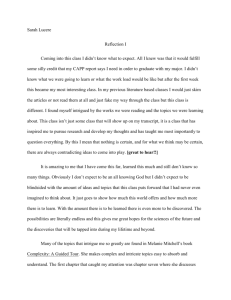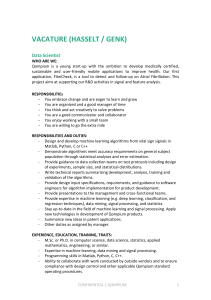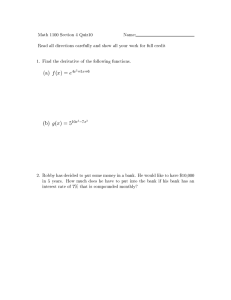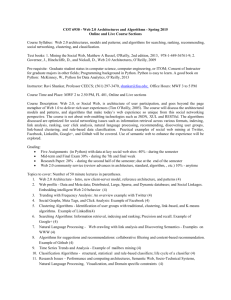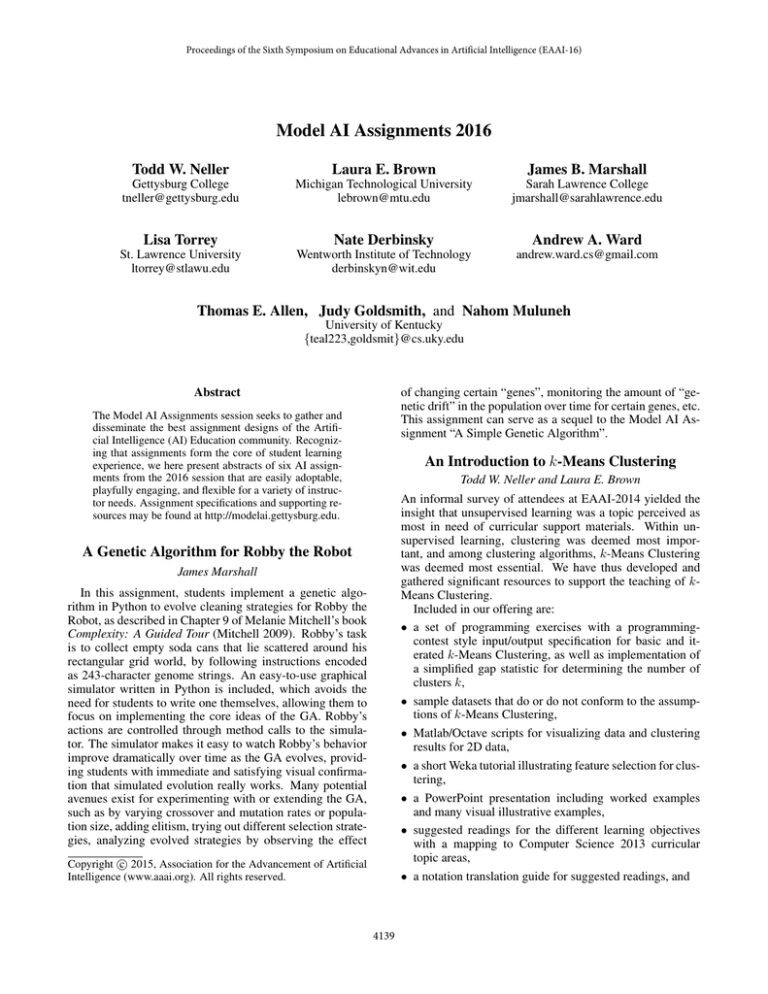
Proceedings of the Sixth Symposium on Educational Advances in Artificial Intelligence (EAAI-16)
Model AI Assignments 2016
Todd W. Neller
Laura E. Brown
James B. Marshall
Gettysburg College
tneller@gettysburg.edu
Michigan Technological University
lebrown@mtu.edu
Sarah Lawrence College
jmarshall@sarahlawrence.edu
Lisa Torrey
Nate Derbinsky
Andrew A. Ward
St. Lawrence University
ltorrey@stlawu.edu
Wentworth Institute of Technology
derbinskyn@wit.edu
andrew.ward.cs@gmail.com
Thomas E. Allen, Judy Goldsmith, and Nahom Muluneh
University of Kentucky
{teal223,goldsmit}@cs.uky.edu
of changing certain “genes”, monitoring the amount of “genetic drift” in the population over time for certain genes, etc.
This assignment can serve as a sequel to the Model AI Assignment “A Simple Genetic Algorithm”.
Abstract
The Model AI Assignments session seeks to gather and
disseminate the best assignment designs of the Artificial Intelligence (AI) Education community. Recognizing that assignments form the core of student learning
experience, we here present abstracts of six AI assignments from the 2016 session that are easily adoptable,
playfully engaging, and flexible for a variety of instructor needs. Assignment specifications and supporting resources may be found at http://modelai.gettysburg.edu.
An Introduction to k-Means Clustering
Todd W. Neller and Laura E. Brown
An informal survey of attendees at EAAI-2014 yielded the
insight that unsupervised learning was a topic perceived as
most in need of curricular support materials. Within unsupervised learning, clustering was deemed most important, and among clustering algorithms, k-Means Clustering
was deemed most essential. We have thus developed and
gathered significant resources to support the teaching of kMeans Clustering.
Included in our offering are:
• a set of programming exercises with a programmingcontest style input/output specification for basic and iterated k-Means Clustering, as well as implementation of
a simplified gap statistic for determining the number of
clusters k,
• sample datasets that do or do not conform to the assumptions of k-Means Clustering,
• Matlab/Octave scripts for visualizing data and clustering
results for 2D data,
• a short Weka tutorial illustrating feature selection for clustering,
• a PowerPoint presentation including worked examples
and many visual illustrative examples,
• suggested readings for the different learning objectives
with a mapping to Computer Science 2013 curricular
topic areas,
• a notation translation guide for suggested readings, and
A Genetic Algorithm for Robby the Robot
James Marshall
In this assignment, students implement a genetic algorithm in Python to evolve cleaning strategies for Robby the
Robot, as described in Chapter 9 of Melanie Mitchell’s book
Complexity: A Guided Tour (Mitchell 2009). Robby’s task
is to collect empty soda cans that lie scattered around his
rectangular grid world, by following instructions encoded
as 243-character genome strings. An easy-to-use graphical
simulator written in Python is included, which avoids the
need for students to write one themselves, allowing them to
focus on implementing the core ideas of the GA. Robby’s
actions are controlled through method calls to the simulator. The simulator makes it easy to watch Robby’s behavior
improve dramatically over time as the GA evolves, providing students with immediate and satisfying visual confirmation that simulated evolution really works. Many potential
avenues exist for experimenting with or extending the GA,
such as by varying crossover and mutation rates or population size, adding elitism, trying out different selection strategies, analyzing evolved strategies by observing the effect
c 2015, Association for the Advancement of Artificial
Copyright Intelligence (www.aaai.org). All rights reserved.
4139
• links to online demos, videos, and relevant MOOCs.
specified in the assignment description. The tester program
is capable of detecting many subtle problems in students’
code, including: not performing crossover entirely correctly,
performing mutation with a higher or lower probability than
expected, selecting genomes from the population in a way
that does not correspond to their fitness, etc. Students can
use the tester to receive immediate feedback as they develop
their code. The tester also makes grading the assignment
considerably easier for the instructor. This assignment can
serve as a prequel to the Model AI Assignment “A Genetic
Algorithm for Robby the Robot”.
It is our hope that instructors will pick and choose from
these resources we and others have developed to meet pressing pedagogical needs in this important area of AI.
Python Console-Animation Suite
Lisa Torrey
This is a suite of exercises that apply five core AI algorithms to five classic puzzles and games within a consistent
Python framework. The algorithms are breadth-first search,
A* search, simulated annealing, minimax, and Q-learning.
The application domains are a maze, a sliding-block puzzle, the N-queens problem, tic-tac-toe, and Pac-Man. The
exercises have all been used as in-class examples or short
homework assignments in an undergraduate introductory AI
course. They keep students engaged by working on a range
of popular problems, and by adopting a consistent approach,
they reduce cognitive load. Console-based animation allows
for visualization without the overhead of a graphics library.
The exercises are accessible to any student who can work
with classes, strings, tuples, lists, sets, and dictionaries in
Python.
Adventures with Prolog: Entering the
Dungeon Lord’s Lair
Thomas E. Allen, Andrew A. Ward, Judy Goldsmith, and
Nahom Muluneh
Our Artificial Intelligence survey course includes units
on Propositional Logic, Predicate Logic, Situation Calculus,
and Resolution. As an application of this material, we introduce Prolog. Our students, mostly undergraduate juniors
and seniors, have had success with Python and C++. Often,
however, they find Prolog bewildering. “How do I write a
loop?” they ask us. “How do I assign X a new value?!”
We present an assignment with a theme inspired by
Tolkien and “D&D” style role-playing games: Students
implement a simple maze and a character that navigates
through it, avoiding enemies and obstacles and searching for
treasure. In the first assignment, students only implement
the maze and show that their character can navigate through
it in a manner that does not involve infinite recursive descent.
In the second, we introduce treasure guarded by enemies. By
breaking the assignment in two, and going through solutions
of the first part, students are more likely to succeed in the
second part, and thus feel a sense of accomplishment. The
assignment is also easily adapted from semester to semester
to incorporate different themes and challenges.
An Introduction to Classification: A CS2
Object-Oriented Programming Project
Nate Derbinsky
Through a series of scaffolded steps, this CS2 project asks
students to develop a flexible framework for evaluating classification algorithms. In each phase of the project, students
are provided documentation, unit tests, and supporting compiled code. The focus is on object-oriented concepts, such
that the application can “mix and match” any classification
algorithm with any training/testing-pair evaluation dataset.
The purpose of the project is for the students to apply principles of object-oriented programming to a relatively largescale, real-world problem. Along the way students learn
about basic machine learning concepts; issues and tradeoffs
related to knowledge representation (e.g. the efficiency of
sparse vs. dense feature vectors); and implement two basic
supervised learning algorithms (1-NN, ZeroR), as well as a
simple form of reservoir sampling.
References
Mitchell, M. 1996. An Introduction to Genetic Algorithms. Cambridge, Massachusetts, USA: MIT Press / Bradford Books.
Mitchell, M. 2009. Complexity: A Guided Tour. New York:
Oxford University Press.
A Simple Genetic Algorithm
James Marshall
Students implement a simple genetic algorithm in Python
to evolve binary strings of 0s and 1s. The assignment is
based on an exercise from An Introduction to Genetic Algorithms (Mitchell 1996). Because GAs are inherently probabilistic, debugging them can prove challenging and frustrating to students. Therefore a robust automated tester program
is included, which can be used by students and instructors
alike to detect bugs in students’ code. The assignment provides significant structure by breaking the GA implementation into 8 building blocks, corresponding to 8 functions that
can be written and tested in an incremental, modular fashion. The required input/output behavior of each function is
4140

